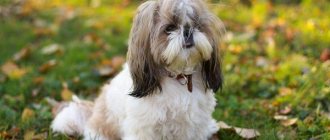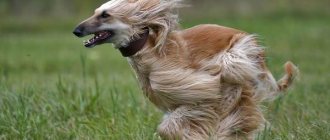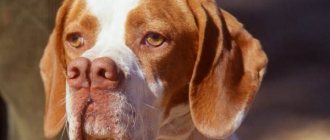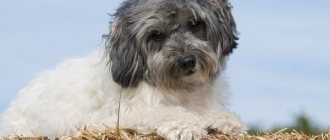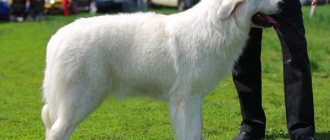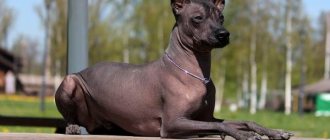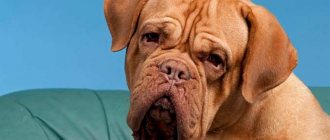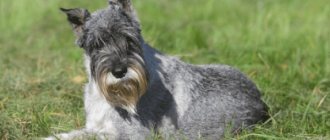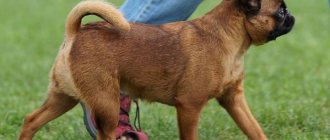Breeders who want to have a watchman and at the same time a devoted friend choose the Schipperke dog breed. The pet with miniature pointed ears and thick black hair looks like a Spitz, but has the disposition of a shepherd dog. Despite its modest size and attractive appearance, the Schipperke cannot be classified as an ornamental breed. The dog, which is not inferior in courage to the Alabai, is used in the service of rescue teams, security companies, and the police.
Maintenance and care
Regardless of whether the pet lives on the street or at home, it cannot be locked for the whole day either in an apartment or in an enclosure. This is not a decorative, but a working breed of dog, so the animal needs daily walks and training. Representatives of this breed need to realize their own usefulness. Otherwise, they will find things to do on their own, and not always good ones. For example, waking up the owners with a loud bark, putting things in order in closets, the kitchen and other rooms of the home.
A trained animal will not allow itself to spin under its feet. It can be kept outside without much hassle in winter. These dogs love snow, and they also tolerate heat well. However, regardless of their age and gender, the breeder will be forced to constantly monitor the condition of their coat
It is especially important to do this during seasonal shedding, since the undercoat accumulated over the winter often remains on the guard, which leads to the formation of tangles.
Shedding for these dogs lasts on average two weeks, and to remove dead hair you need to use both a single-row and a slicker. On other days, to maintain the aesthetic appeal of a dog's coat, it is enough to brush it a couple of times a week with a massage brush.
The coat of a well-groomed dog is shiny and strong. Her skin is not prone to allergies and drying out. If the owner notices excessive hair loss from the fur coat, this indicates poor nutrition and the need to consult a veterinarian.
Schipperkes do not need to be bathed too often, even if the owner thinks that the dog should be perfectly clean. A working dog, as a rule, has a rough and straight coat, which is why it is not prone to picking up and accumulating dirt. For dogs participating in exhibitions, breeders buy special shampoos for black fur. With their help, they mask the rust that appears in pets during prolonged exposure to the sun. You should bathe your pet no more than once every two months.
Ears and eyes must be examined constantly; if contamination is detected, they are removed. Wax is removed from the ears with a damp cotton pad. If an unpleasant odor is detected coming from the ears, the dog is immediately taken to the veterinarian. Among other signals that require an urgent visit to the doctor, experts note redness of the skin, swelling, and constant itching of the ears. You can’t do treatment on your own, because it often aggravates the situation.
The eyes are examined regularly; in order to prevent souring, they are wiped once a week with a lint-free cloth soaked in chamomile infusion. At the same time, take a new cloth for each eye. If there is redness and souring, the dog is taken to the veterinarian. The same rule applies to cases where the animal has profuse lacrimation and swelling of the eyelids.
It is advisable to wash the paws after each walk rather than wipe them with a damp cloth. This makes it easier to see whether cracks or other wounds have appeared on the pads. If they are present, they are treated with an antiseptic. To prevent cracks from appearing, it is necessary to lubricate the paw pads with vegetable oil. In addition, it must be included in a nutritious diet.
To treat claws, purchase a nail clipper, which is used no more than once a week. After cutting off the edges of the claws, they are filed with a file, and the dog is accustomed to a similar procedure from a young age, rewarding it for its patience. It is imperative to brush your pet’s teeth, otherwise they will quickly become covered with yellow plaque and wear off. In addition, dirt accumulates between them, which causes the formation of tartar.
You cannot use human paste, as dogs do not like the menthol smell and foam. You need to walk your dog two or even three times every day, and the evening walk should be longer. Treatment for worms and other parasites must be carried out in a timely manner. If ticks are found, you should immediately consult a doctor.
Pros and cons of the breed
The Schipperke, like many breeds, has both its strengths and weaknesses. Among the advantages, they note that these are smart, devoted and faithful animals, ready to always defend their person.
Moreover, if you need to get involved in a fight, they will fight until victory. In principle, the “Belgians” do not know how to retreat.
They are also smart, quick-witted and love their owners. They will become a great friend for children and will always protect them. They have good health and can eat both factory feed and natural food.
They can live both in an apartment and in a large house. The main thing is to provide the dog with regular walking. Cheerful and active, these four-legged animals will brighten up the lives of other outdoor enthusiasts.
By the way, it is precisely from the restlessness of dogs that the first disadvantage “follows” - if you are looking for a dog with which you do not need to walk often and a lot, then the Schipperke is not your option. They require not just walking on a leash, but also games and various types of entertainment. Therefore, you will need to carry balls, frisbees, and activity sticks with you.
The coat requires regular grooming and brushing. Just like the ears. There is also a complex genetic disease such as mucopolysaccharidosis, which manifests itself in adulthood. Training and training are also extremely important - without them, the dog will become uncontrollable.
However, if you feel that you can cope with raising an animal or you already have experience and skill in this, you can buy such a puppy. He will become a wonderful and loyal friend for you.
Appearance
Schipperke (schipperke) is a small shepherd dog with a harmonious, strong, square build. She has a very expressive face, pointed ears and short black fur. In general, the Schipperke's appearance should reflect strength, endurance and willingness to work. Average weight 4-7 kg.
The Fédération Cynologique Internationale (FCI) standard allows only black color in the breed. In England, golden Schipperkes are also allowed, and in America - gold, chocolate, blue and black and tan. There are some differences in appearance too. Thus, American type dogs are heavier, with thicker, richer hair and an expressive head, while European type dogs are more graceful and light.
The head is not too long and rather wide, wedge-shaped. The stop is noticeable. The forehead is wide, the upper lines of the muzzle and skull are parallel. The muzzle tapers towards the nose, its length being approximately 40% of the length of the head. The bridge of the nose is straight. The lobe is small, black. The lips are close-fitting and black. The teeth are healthy, firmly set, scissor bite, straight is allowed. The eyes are dark brown, almond-shaped, small. Eyelids black. The look is lively and mischievous. The ears are small, pointed, erect, triangular in shape, set high, very mobile.
The neck is strong, strong, because of the collar it seems very voluminous, it is carried high, the upper line of the neck is slightly curved. The body is wide and short. The topline is straight, often slightly raised from the croup to the withers. The withers are well expressed. The back is straight and short. The loin is wide. The croup is horizontal, smoothly rounded, which is why it is compared to the croup of a guinea pig. The chest is wide with rounded ribs and descends to the elbows. The hemline is slightly tucked. The tail is set high. Bobtail is normal for the breed.
Some dogs are born with short tails. At rest, the tail is naturally long, reaching to the hocks, hanging down, slightly curving at the end. When moving, it can rise to the level of the back. A curled tail or thrown over the back is also acceptable.
The limbs with very good bones are placed under the body. The front are straight, parallel, their length from the ground to the elbows is approximately half the height at the withers. The hindquarters, when viewed from behind, are parallel with long, muscular thighs. The hock joints are well defined. Dewclaws are undesirable. The paws are round, small, the toes are well assembled with very strong, black short claws.
Double wool. The guard hair is abundant, thick, rather coarse, straight, strong in texture, durable and dry to the touch. The undercoat is soft and dense. The hair on the ears, head, front of the legs, hocks and metatarsals is noticeably shorter. On a body of medium length, fits tightly. It is slightly longer on the neck, forming a collar, and “pants” on the back of the hips. The hair on the tail is the same length as on the body. The color is exclusively black. With age, a little gray appears on the face.
To whom do you not recommend the Schipperke breed?
The Schipperke is definitely not suitable for people who want the dog to lie in the hallway all day and be occupied with itself, or for people who are annoyed by a dog constantly spinning at their feet. If you are looking for a calm lap dog, this is a bad choice. If you are retired and find it difficult to go for walks, you might want to look for a calmer breed. Schipperkes quickly learn everything - both good and bad. It may happen that the dog will be smarter than its owner: a Schipperke puppy can challenge you with ingenuity. We must be able to direct his energy in the right direction. It is not necessary to exercise every day, but it is necessary to take into account some aspects of canine psychology. In general, I do not recommend the breed to phlegmatic, irritable people.
View the embedded online gallery at:
I am looking for a constant companion who is not tired of walking, who loves the company of people and dogs, cheerful, always ready to play, but at the same time adequate, understanding when his activity is unnecessary. Small in size, but not fragile. Without special care for the coat. Is Schipperke right for me?
Definitely - YES!
Mating
The bitch is ready for reproduction already with the appearance of her first heat, at 8-9 months of age. But dogs should not be bred earlier than 2 years of age: by this moment, all the organs of the bitch are fully formed, and she is fully ready to bear offspring.
The female and male dogs must be tested for genetic diseases before being allowed to breed. The bitch must have all her vaccinations according to schedule. Only in this case will Schipperke puppies be guaranteed to be protected from many canine infectious diseases (distemper, rabies, enteritis).
For mating, the bitch arrives at the dog's territory. Schipperkes are knitted by themselves, without human help. After 24-48 hours, a control mating is carried out to consolidate the result.
Description of the breed
The Schipperke is a well-built, small dog. Males differ from females in size and proportions. The average height of an adult is from 25 to 33 cm. For the standard, the size of the dog is not particularly important, and the following characteristics play an important role:
- Weight. An acceptable weight is considered to be from 3 to 9 kg, and the optimal range is 4–7 kg.
- Back length. This indicator should be equal to the height at the withers.
- Dog muzzle. It should be shorter than the skull and occupy less than 1/2 of the length of the head.
Breed standard:
- The body is square. The neck is short, the chest is strong, and the withers are developed. The groin should be tightened.
- The head is shortened and wedge-shaped.
- The eyes are almond-shaped and small. The color of the iris is brown.
- The ears are small, pointed at the tips.
- The limbs are strong. The hind legs are slightly longer than the front legs.
The Schipperke has no tail from birth and is usually docked short. Dogs have no folds on their skin, and it is pigmented black. Dense undercoat is softer than wool. It provides reliable protection from moisture and wind. The black fur grows densely. The hairs on the ears, limbs and muzzle are shorter. The longest hair is in the area of the mane, frill and “panties” (hind and forelimbs above the elbows).
Bichon Frize
This cute little dog can become a true friend to a person. These animals do not seek to dominate. They are not capricious. Dogs adore their owners. This dog is ideal for families with children, as it loves active walks and games.
Fluffy dogs are happy to communicate with all people, familiar and unfamiliar, but most of all they love children.
They are ideal pets, but they can frighten children with their loud barking.
Source
White dogs are distinguished by their special charm and elegance. Find out more interesting facts about white dog breeds on the Purina.ru website.
Finding and purchasing a puppy
Finding the Schipperke dog breed in Russia is a whole quest. Not every regional club can boast of contacts with breeders, and there are no nurseries in the country at all. The breed is so rare that you will most likely have to travel to Europe to acquire a high quality puppy suitable for breeding and a show career.
The babies themselves should be black, well-fed, reminiscent of a Spitz, but with a rougher muzzle. Don't see gray puppies, a miracle won't happen, color defects don't disappear with age
Also pay attention to the behavior of the bitch and the entire litter: cowardly, aggressive or lethargic puppies and the female are a reason to think about the integrity of the breeder
Check all documents for parent dogs, breeding permits and initial documents of the litter, this way you will protect yourself from purchasing any other breed or mixed breed.
Price
Designer mestizos are created, firstly, for prestige, and secondly, to correct the parameters of well-known dog breeds used for their breeding. The hybrid we are considering is a unique creature. It has an attractive appearance and a gentle disposition.
The character of the thorn is liked by everyone who interacts with him. However, acquiring such a four-legged friend in Russia is not easy. It is bred not only by professionals, but also by amateur breeders. The price of a thorn in Russia is from 400 to 1000 dollars.
Selection criteria and puppy price
Having decided to have a pet of this breed, the first step is to decide on the purpose for which it is purchased.
Having familiarized yourself with the results of recent exhibitions, you can see that the prizes are occupied by the American type - large with abundant hair. Therefore, if you are looking for a future champion, choose the American. If you need a compact dog that does not take up much space, but is very functional, choose the European Schipperke.
The next steps in choosing a puppy will be:
- searching for a nursery with good recommendations;
- meeting the baby's parents;
- checking the availability and authenticity of documents, namely a puppy card and a veterinary passport;
- assessment of the living conditions of animals, their appearance and health status.
Important! It is necessary to find out what kind of mating the puppy is the result of - planned or not. Unplanned offspring may not be registered and there will be no documents for them.
First of all, you should pay attention to the following indicators:
- puppies must have clean eyes, ears and fur;
- they should move confidently without limping on their feet.
Schipperke puppies who will have a show career in the future have even more requirements:
- presence of a mark;
- maintaining the correct proportions of the body and the ratio of length to width of the muzzle;
- correct fit and length of ears;
- square body shape.
Important detail: the tail should not have any creases. And it is necessary to immediately assess the length of this part of the body, since over time this parameter relative to the hock joints will not change. Sometimes puppies are born without a tail at all - this is not a defect, and such a representative is suitable for exhibitions. The quality and color of the wool are of great importance. It should be shiny, completely black, with no signs of dandruff. The color of the undercoat can be determined by the color of the dog's heels. Gray color is typical for light feet, black for dark and brown feet.
Small breeds of dogs are best suited for apartment living, such as: Biewer-York, Pug, Yorkshire Terrier, Pomeranian, Chihuahua, French Bulldog, Pekingese, Dachshund and Miniature Pinscher.
The price of puppies of this breed ranges from 650-1300 US dollars.
Interesting Facts
The Shipu breed, which recently became popular, unlike other designer dogs, has the best chance of being officially recognized. She has important reasons for this:
- the dog has won the love and recognition of many people;
- puppies live up to expectations of good health, intact intelligence, and friendly character;
- Breeders are working to develop a breeding program in order to secure a successful result for the subsequent offspring of a hybrid dog.
It takes time for nurseries to work, to create a kennel club for ship lovers, where all the documents for individuals of this breed will be collected. Only if important conditions are met will the breed receive registration and recognition from all dog handlers. The main thing is that thorn dogs have a future.
Schipperke character
The Schipperke needs firm, but gentle and consistent training. This dog is quite difficult to train because it quickly loses interest in exercise. However, with proper training, the Schipperke can become a well-mannered and polite dog.
Small shepherd dogs are distinguished by vigilance and self-confidence, liveliness and agility. They are very smart and quick-witted. For the most part, Schipperkes are tireless and resilient.
By nature they have courage and fearlessness, they protect the house and yard well, warning the owner with a loud bark about the appearance of any uninvited guests. They are rightly called “yard” dogs, since they can only control a small area immediately adjacent to the house.
Schipperkes get along well with all members of their owner's family and are sincerely attached to people. It is for their loyalty and devotion, to the point of fanaticism, that these black companions are valued. To avoid problems with cats and other animals, do not forget about the early socialization of the puppy.
Dogs of this breed are tolerant of children; a Schipperke cannot become a nanny, but the dog can look after children. Schipperkes usually get along peacefully with other dogs, but bullies are always put in their place.
The little shepherd does not forget its “hunting” past: it deftly and easily copes with rodents, and can even catch a rabbit or a mole.
The Schipperke is a rather expensive breed; on average, the cost of Schipperke puppies starts from 45,000 - 50,000 rubles and can reach 60-70 thousand rubles
Please note that offers for the sale of puppies appear quite rarely, so if you have already decided that you want this particular breed, it is better to find a Schipperke nursery and stand in line for puppies.
Socialization
Early socialization of the Schipperke is necessary to develop an adequate perception of other animals and people. After the routine vaccination, the puppy is taken out into the world - to the puppy pad. There he gains experience in communicating with his peers, which allows him not to be afraid of his four-legged brothers in the future.
If there are small children in the family, the Schipperke puppy will become their faithful friend in games and mischief. The younger generation should not be left unattended. A child who does not measure his strength may accidentally hurt the dog, for which the dog may snap back or bite lightly in response.
If there are small pets in the house, such as hamsters, guinea pigs, birds, the dog may perceive them as potential prey. It is better to hide such pets away from the Belgian. But with cats and dogs, quite friendly relationships can develop, especially if everyone is about the same age and grows up together.
Attitude towards strangers
Suspicious and wary by nature, Schipperkes are extremely vigilant. These amazing dogs consider themselves great watchdogs, they simply believe it. Fearlessness and devotion are hidden behind the deceptive appearance of small animals. Pets strive to be useful to their owner, so they will definitely warn about the approach of strangers. The Schipperke will immediately warn about strangers who have aroused suspicion or disrupted order from the dog’s point of view with a piercing and sharp bark.
Reserved by nature, the breed requires early socialization in order to respond adequately to the environment and people. Otherwise, the dog will often bark and even rush at strangers, trying to bite them.
If a stranger often appears in the house where the animal lives, then as a result of slow rapprochement, frequent communication can lead to the Schipperke and the stranger becoming good friends.
Nutrition
The owners of most decorative dogs prefer to feed them with a ready-made commercial product - dry/wet food. Today it can be purchased at any store or supermarket. The advantage of a ready-made diet is that there is no need to calculate the dosage.
It is sold by the portion. That is, to feed your pet, it is enough to pour 1 bag of food into his bowl. There is another option - buying ready-made diet in bulk. In this case, for a medium-sized mixed breed, it is enough to add 200 grams of feed. We recommend using a measuring cup!
Shipoo puppies need a lot of protein, and ready-made diets don't have enough of it. That is why dogs under 1 year of age are advised to be given natural foods, including fish, milk, meat, eggs and cottage cheese.
They contain not only healthy proteins, but also microelements. When regularly introduced into the dog’s body, they ensure full growth and development. The dog should be prevented from eating sweets, smoked meats and dishes prepared with a lot of spices and salt.
Dog care
Shepherd dogs guarding a herd of livestock or grain reserves were not kept in the house, but lived in a booth in the yard, so the Schipperke normally tolerates frosts down to -20° and is not afraid of heat. Thick fur repels water, warms the body, and after rain or swimming in the river, an adult dog will not get sick. It is better not to let puppies who have not had time to get vaccinated leave the house.
Tiny pets can be left in an indoor enclosure for a short time. When the owner is absent, inquisitive puppies turn the apartment into a battlefield. A small shepherd dog, which can easily run 8–10 km a day, should be walked twice a day. You need to walk the streets with your dog on a leash, otherwise it will be difficult to catch a pet that has gone to explore the area.
To care for the Schipperke's coat, it is recommended to purchase a bristle comb, which is used to comb the dog a couple of times a week. In male dogs, after heavy shedding, which usually occurs in the spring, the hair stops falling out. Bitches have a new coat every six months after the birth of their puppies.
They bathe the Schipperke that is kept in the house once a month, using a minimum of shampoo. Dogs that are prepared for exhibition events are washed after 14 days. After each hygiene procedure, carefully comb the hair with a grooming comb.
Clean your pet's ears with a cotton pad soaked in Doctor Vic antiseptic solution. The eyelids are wiped with a rag soaked in a decoction of chamomile. Such manipulations are started once every 7–8 days. Every 3 weeks, brush your teeth with a brush and animal paste and rinse your mouth.
After returning from the street, it is recommended to wipe the pads on the pet’s paws with a wet cloth and lubricate them with cream during cold periods.
The nails of dogs living in the house are trimmed with clippers, accustoming them to the procedure from birth. If a vessel is accidentally damaged, wipe the wound with cotton wool soaked in Chlorhexidine.
Schipperke nutrition
Breeders decide in different ways what to feed a small shepherd dog. Natural food is suitable for any dog, but it requires additional time for heat treatment of products and the inclusion of vitamin supplements in the diet. Ready-made food such as Royal Canin has a balanced composition; after consuming the complex, the dog becomes even more active.
The pet's daily feeding ration should not exceed 5% of body weight, more than half of the food volume is:
- internal organs of animals;
- lean meat;
- boneless fish.
Attention! Small puppies are fed porridges prepared with milk; for pets older than six months, rice, buckwheat, and oats are brewed in boiling water. Beef or poultry is not passed through a meat grinder, but cut into pieces
How often you need to feed your Belgian Shepherd depends on its age:
| Month | Number of times per day |
| Up to 2 | 6 |
| From 2 to 4 | 5 |
| 4-6 | 4 |
| 6-8 | 3 |
| from 9 | 2 |
Owner reviews
Elena 34 years old
We thought for a long time which breed to choose and accidentally saw a photo of these adorable dogs. We did not regret our choice. They are nice and very friendly to their owners. Thanks to our dog, I spend a lot of time outside.
Christina, 20 years old
For a long time I dreamed of a purebred dog that would protect me. But since I live in a small apartment, I couldn’t get myself a big dog. But I didn’t want a small room. I am very glad that I accidentally saw an advertisement for the sale of a “Schipperke” with a description of its character. I immediately realized this was my option. Now this is my best friend and protector.
Igor, 40 years old
The children spent a long time trying to persuade us to get them a puppy. My wife and I resisted, because this is a big responsibility. And of course we will take care of the animal. But our children are lucky, they have a kind grandmother who gave them a Schipperke puppy. After reading about the breed, we realized that we would not worry too much about caring for the pet. We took to him immediately, a very sweet puppy. The children are happy, they run around with him in the yard all day long. And for training, we hired a dog handler who comes to us every day.
The attitude of the Schipperke towards the owner and family members
It should be immediately noted that the Schipperke is characterized by increased activity, therefore, this breed is suitable only for active people who are ready to devote time to their dog, engage with it, stimulating mental activity and satisfying the pet’s needs for physical activity
Otherwise, irritable and bored dogs will start entertaining themselves by chewing things and attracting attention by barking.
As for the attitude towards the owner and family members, Schipperkes, loyal by nature, are always ready to protect people to whom they are very attached, even in situations in which the life of the animal itself would be in danger. These confident dogs are ready to demonstrate their courage, but never show timidity.
It should be noted that the Schipperke loves children and does not refuse to play with them, but dogs of this breed are most suitable for families with teenage children who can cope with the animal without torturing or annoying it. Sensitive and proud, Schipperkes do not like to be teased or treated poorly.
Representatives of the breed are very playful and are always ready to actively spend time with members of their family, simply running in the yard or park. Schipperkes travel with pleasure and do not refuse to ride in a boat or ride in a car.
Education and training
When a cute designer dog moves into your home, everyone is happy. She charges everyone who interacts with her with positive energy. But in order for the animal not to create problems, it should be raised correctly.
We advise you to start training him from the very first days. So, when getting to know a dog, you should demonstrate to him your leadership qualities so that he understands that in front of him is his master, who must obey.
A decorative dog should not be afraid of people! It is important to initially convince him that in this situation he has nothing to fear. Each member of the household should surround him with care. In the presence of this dog, you should speak kindly, do not be rude to it or shout.
It is important to toilet train your dog as early as possible. If the dog lives in the house, he needs to be shown where his litter box is. When he urinates in it, you should not ignore it. Be sure to praise your baby!
The process of his interaction with other animals in the house should be adjusted. By nature, this hybrid is kind and completely non-conflicting, but it can suffer serious psychological trauma if it becomes a victim of a strong beast. Don't let other dogs in the house hurt your decorative pet.
When walking him outside, use a long leash. You should not let him run around, especially if there is a highway nearby. An overly inquisitive spike can easily fall under the wheels of a car. When walking along the road, it is better to take it in your arms.
Never scold the thorn too much - this may frighten him. If your dog does something bad, like shitting on a pillow, verbally shame him and remove him from the room. You should never calm down an offending thorn with stroking or affectionate speech. Otherwise, he will repeat his mistake in the future.
Important point! Don't let your pet beg for food during family meals. So that he does not bother the household, he should be fed at the same time as everyone else. Fill his bowl with food before the family sits down to the table.
Personality of Dwarf German Shepherds
Breeders notice that, despite their physical imperfections, dwarf “Germans” are no different in character from their counterparts. In some aspects they even perform better.
Features that breeders highlight:
- High intelligence;
- More obedient and easier to train;
- They have a more acute sense of smell and hearing;
- Easy to maintain due to small size.
The shepherd's guarding and protective abilities were not affected in any way due to growth failure.
They are not inferior to full-fledged “Germans” in training and intelligence. Good with children. For many owners, their small stature, on the contrary, is a huge plus, because in this case the dog can be kept in an apartment without problems.
Expert opinion Semyon Kirillovich Kozhevin Expert dog handler. Ask a question to an expert “When we are faced with the birth of such puppies, we, of course, have to nurse them and treat them in order to brighten up their physical imperfections. Of course, giving away dwarfs at the same price as healthy “Germans” is out of the question. I know that in some other nurseries they euthanize puppies, we don’t do this, but we think that this is a marriage. Most often, if a dog ends up with a bad owner, it suffers and dies quite quickly. To place such puppies you need more time, you need to pay closer attention to people, because you still want the dog to be happy in the family.”
Nurseries
Five reasons to buy a puppy from a kennel:
- Support and assistance on care and education issues.
- All individuals of the breed are examined before mating.
- Puppies are tested for carriers of genetic diseases.
- Puppies undergo socialization, receive the necessary vaccinations according to their age, and eat high-quality food.
- Guarantee of breed purity, availability of documents.
Nursery addresses:
- Moscow region, Pushkino, nursery "Muranovo" https://muranovodog.ru/
- Moscow region, Krasnogorsk, nursery “S Krasnaya Gorka” https://krasnogorka.ru/contact.shtml
For a person choosing a pet, the smallest shepherd dog will be an excellent companion for walking together. A perky and playful dog, at the same time promptly responding to the commands and mood of the owner, not demanding in care and maintenance - there are a lot of advantages in a small dog with a huge loving heart.
a brief description of
The Schipperke is one of the most loyal dogs in the world. Despite their very modest size, the animals are very selfless; they are excellent watchmen and shepherds. In the past, these dogs protected huge herds even at the cost of their own lives.
These are very lively and active animals, with an open character and great potential. Their energy needs to be fully realized. The easiest option is long walks. Schipperkes are very fond of outdoor games, they enjoy spending time with their family, and love forays into nature. They get along well with other animals, although it is better to introduce them to cats from early childhood.
Schipperkes are good at adapting to different living conditions; they feel equally comfortable in all climatic latitudes, as well as in large families and with a single owner. The main feature of these animals is their flexible character; they behave well with children, gladly take part in their pranks, go for walks and simply relax next to them.
The only drawback is the loud and piercing bark, which is not particularly noticeable and even useful if you live in a private house. These abilities allow the dog to perform a 100% guard function. Despite the fact that this dog most likely will not be able to stop the attacker, it will announce his presence to the entire area. Only the deaf will not hear this bell.
However, the dog himself is not at all embarrassed by his size and he may well rush to attack an enemy many times larger than himself. This breed, like many others, needs early socialization, obedience courses and education. They have a good disposition, friendly and very gentle character. In loving hands, the rich inner world is revealed to the maximum.
How to choose a puppy
Choosing a puppy is a difficult and responsible moment. Initially, a person determines whether a Schipperke dog is suitable for him. If you lack free time, it is better to abandon the acquisition idea. Active, playful by nature, the Schipperke puppy requires a lot of attention, time for exercise and training. If the owner comes home late in the evening and leaves early in the morning, then the dog will grow up withdrawn and aggressive when alone. Also, if a person likes to spend his free time on the couch in front of the TV, then it’s worth looking for a calmer companion.
To buy a puppy, it is better to turn to professionals, experienced breeders. Here they will give advice on caring for and raising your baby. A reputable breeder will be happy to demonstrate the living conditions of the puppies and the bitch, boast about the achievements of the Schipperke dog, take photos of puppies from other litters, and tell everything about the breed.
The puppy's parents must be tested for the genetic disease mucopolysaccharidosis. If the mother or father does not have the test result, it is better to refuse the purchase.
Description of the breed with photos
The Schnauzer Mittel is part of the Pinscher section. The dog is good-natured and moderately active. Of all the service dogs, she is the smallest, but this does not prevent her from being a good guard. She is easily able to protect the property of her owner and himself.
The breed's abilities are actively used at customs. The dog can easily detect drugs and explosives. During the Great Patriotic War, the miniature schnauzer helped the orderlies and was assigned to the Red Cross. On the battlefield, he brought bandages and medicines.
Due to his reserved character, he is trusted with the role of a guide. The dog's devotion knows no bounds, so he will follow his owner anywhere without fear. Becomes a reliable friend for both adults and teenagers.
The description of the Miniature Schnauzer breed includes a list of standards, parameters and color.
Breed standards
- Due to the massive skull, the head is large. The forehead is flat, expressed by thick eyebrows and has no wrinkles. The head is equal in length to half the body.
- The breed's muzzle looks like a dull blade. It has a straight bridge of the nose with large nostrils on a black lobe.
- The dog has a scissor bite, regular. The teeth are white and sharp. The jaws are strong. The incisors are located on the same line and the upper row tightly overlaps the lower one.
- The main distinguishing feature is a beard, mustache and eyebrows of increased thickness.
- The eyes are dark and almond-shaped. Light color is not allowed.
- The muscular neck is very strong. The scruff line is beautifully shaped and of medium length. Well defined withers are raised. The shoulder blades are pressed tightly to the back.
- Previously, the tail and ears were docked to protect the animal from rodent bites. Modern fashion allows you to leave cute hanging ears and a slightly curled crescent-shaped tail. But even with cropped erect triangular ears, the dog’s appearance can only benefit. If the tail is docked, then 3 vertebrae are left.
- Square physique. The height at the withers and length are approximately equal. The body is muscular and lean with the chest moderately protruded forward. The back is flat, elastic and short. The stomach is slightly retracted.
- It has straight and widely spaced forelimbs. The paws resemble those of a cat - round and short, with small claws and soft pads.
- The muscular hind limbs stand parallel to the ground. Their fingers are short, with dark claws.
Size and weight
Males and females are different from each other.
The dogs have retained their shape and performance despite the fact that they have not performed their official functions for a long time - protecting farm territories. The appearance and dimensions have not changed for many years.
Color and coat type
Special attention is paid to wool. Its quality is checked at exhibitions and must meet strict parameters
The coat should be wire-like and stiff. But it is worth noting that with a coarsened outer coat, there is a very soft undercoat. The coat is straight and lies close to the body.
There are two color options. One is completely black, evenly distributed on the body. But it is permissible to have a white spot on the chest. The second one is called pepper and salt. Each hair contains black and white colors. Sometimes there may be a black mask on the animal's face.
Application
Schipperke (Flemish - small shepherd dog) at the beginning of the formation of the breed was used as a hunter of small rodents, which besieged the homes and grocery stores of medieval Europeans in huge numbers.
Nowadays there is no such need, and Belgians can increasingly be seen in families as companions, as well as in exhibitions and shows.
Temperament and character traits of the Schipperke
The modern Schipperke is a family pet, serving as both a companion and a protector. The breed is curious, energetic and cheerful. He is always on the move, interested in everything around him and loves to explore new places.
Such a restless pet needs frequent, long walks to get rid of excess energy. Otherwise, he will behave too actively at home - rush around tirelessly, become attached to household members and guests, and get underfoot. Schipperke is an excellent traveler; he especially enjoys car rides, during which the dog can look out the window.
The pet can play and frolic for hours, so it is a good option for families with children. But you will have to forget about peace and quiet - the company will be restless
In addition, he does not get along with very young children - their carelessness can irritate the pet
The dog's modest size does not prevent it from being brave, strong, and fearless. If necessary, she will enter into battle with an opponent who is much larger in size. But an ill-mannered dog can cause problems - it can be aggressive, even towards its owner. And here it becomes clear why the Schipperke is called the “black little devil.”
Representatives of this breed are very vigilant; not a single extraneous sound will go unnoticed. The pet will notify you about them with a ringing, loud bark, which can develop into a long trill. This behavior may not be to the liking of both the owners and the neighbors. This behavior is subject to correction; a trained dog is able to quickly fall silent upon hearing a certain command.
Lifespan and reproduction
Shipus are very sweet and affectionate dogs that need loving care. With good care, they live up to 13-16 years! For a designer hybrid, this is a considerable lifespan. Breeders do not provide accurate information about the details of crossing poodles and Shih Tzus for obvious reasons.
This mestizo is rare and expensive, therefore it is considered elite. If breeders start breeding him at home, he will lose this status. However, it is important to select only purebred dogs for breeding, which must fully meet the standard of their breed. It is advisable that they are not older than 7 years.
Health
With an average life expectancy of 13–15 years, Schipperkes are prone to very specific hereditary diseases:
There are two diseases affecting the hip joints at once - dysplasia and Legg Calve Perthes disease (aseptic necrosis of the femoral head). Dysplasia is considered as an age-related disease of all shepherd dogs. The disease is caused by rapid abrasion of the heads of the femurs, which leads to damage to the hard body of the joints. Older dogs are recommended to reduce physical activity and enrich their diet with microelements. With necrosis of the femoral head, the disease is more acute and causes more significant damage. Legg Calve Perthes disease rarely responds to conservative treatment; most often, the animal requires surgery.
Pathologies of metabolic processes - hypothyroidism and rare mucopolysaccharidosis type 111B. Thyroid deficiency is treated with medication, artificially equalizing hormonal levels. With mucopolysaccharidosis (observed in 15% of the breed), the consequences can be more destructive than the disease itself, so treatment is selected purely individually, including symptomatically.
Ophthalmological problems - cataracts and retinal atrophy. Cataracts are most often considered a disease of older dogs, although in fact they can occur at any age. Treatment boils down to slowing down the degenerative process and monitoring the general condition of the dog. Atrophy is a more threatening condition that can occur as an independent disease or be a consequence of injury, inversion/eversion of the eyelids, etc.
Quite rarely - epilepsy.
Names for boys and girls
When choosing a name for your pet, you should first of all rely on the fact that you will pronounce it often. Therefore, the name should be sonorous and short. If you want some unusual name, then start from the fact that you can shorten it and affectionately address your pet.
Often, owners like to give their pets mythical names, with some meaning or meaning something. For many, this is a special process, and most often they know in advance what the pet will be called. And sometimes a nickname comes to mind after you look into the eyes of your new friend.
Alternatively, you can name your pet after your favorite cartoon or movie character. Or delegate this process to children, their imagination works like a charm. And they can come up with something new and original.
We have selected several suitable options:
Names for boys:
- Alex
- Arnie
- Bonnie
- Black
- Weiss
- Willie
- Gray
- Jim
- Dick
- Zinger
- Quinn
- Cake
- Buttercup
- Mitch
Names for girls:
- Isa
- Amelie
- Becky
- Vesta
- Gabi
- Grace
- Dora
- Zara
- Yeti
- Lexi
- Ollie
- Cindy
- Tacy
- Filka

